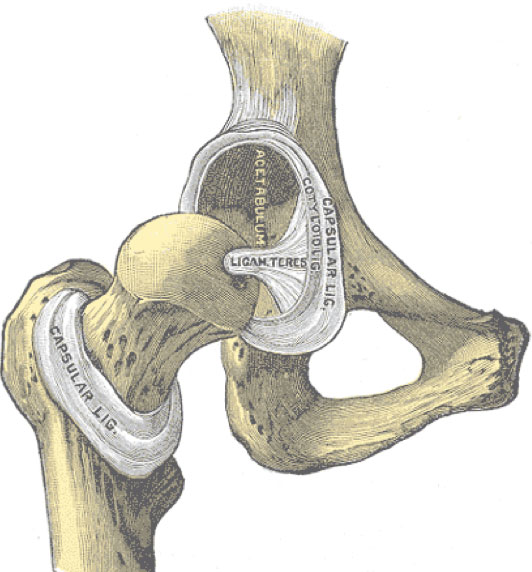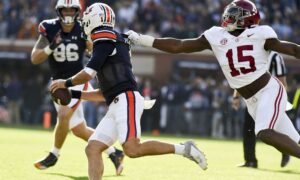The Dynasty Doctor: Labral Tears

In this installment of the Dynasty Doctor, we will report on labral tears of the hip, and how it could be relevant to Percy Harvin.
Hip joints are a structured like a ball-and-socket, the femoral head (top part of the lower leg bone, the femur) secured in a joint space, call the acetabulum, that is surrounded by a dense, fibrous capsule (see image below).

There is a cartilage surface that helps protect the bony surface of the hip joint, and allow the femoral head to glide within the joint in a smooth manner. The labrum is a fibrocartilaginous structure that surrounds the rim of the acetabulum, and it helps support the hip joint in a few ways:
- It serves as a shock absorber, helping to increase surface area of the joint and allow for greater distribution of force, thereby easing stress from movement.
- It helps seal the joint, keeping synovial fluid within the joint, and this helps cut down on wear-and-tear. Pressure within the joint from synovial fluid, maintained by the labrum, helps prevent contact of the femoral head with cartilage in the hip joint, reducing stress that could lead to degenerative changes over time. Fluid and pressure within the joint space absorbs force and helps maintain the hip joint in a healthy state.
- It helps stabilize the femoral head in the acetabulum, resisting lateral and vertical movements – this helps reduce risk of injury to the hip joint that might occur with repetitive usage.
The labrum is felt to have a poor blood supply, especially in the more anterior regions of it, and that might predispose it to injury and complicate healing of tears. This point is debated in the literature. Most injuries to the labrum occur in the anterior location and this is where the most stress is thought to occur in the hip joint (86% to 94%).
Labral tears in athletes are usually from chronic, repetitive activities in sports, such as cutting or rotational movements that stress the hip joint. Other possible causes include traumatic injury, femoroacetabular impingement (FAI), laxity/hyper-mobility in the hip joint, congenital hip dysplasia or degenerative changes in the joint. FAI is a condition that results in the femur pushing against the acetabulum, thereby tearing the labrum. Labral tears are common, and in studies of cadavers, could be found in over 90% of hips. 75% of labral hip tears are not tied to a specific event or source. Common complaints are hip or groin pain, usually aching in quality, and a feeling of clicking or locking in the hip joint.
Treatment is conservative versus invasive:
Conservative
Rest, anti-inflammatory medication (aspirin, ibuprofen, naprosyn) and physical therapy can be tried for 1-3 months. Physical therapy is concentrated on strengthening muscles in the hips and pelvis, and helping the patient modify movement at the hip joint to reduce risk of future or worsening of current injuries. There are some authors who question the effectiveness of physical therapy and the ability of a labral tear to heal itself without surgical intervention.
Surgical / Invasive
If conservative measures fail, a labral tear can be repaired surgically. The most common method is with arthroscopic repair of the torn labrum. This allows for faster recovery and fewer complications compared to open surgery. Arthroscopic repair involves making small incisions and using specialized equipment to shave down damaged parts of the labrum, or tie it back together with sutures. The surgical objective is to reduce pain that results from torn labral tissue and floating debris. Hip arthroscopy is the best way to both diagnose and treat hip injuries, and over 60% of labral tears may have associated cartilage damage. This is important, as if there is significant damage in the joint surface that could complicate surgery, extend recovery time and increase risk for a chronic, degenerative condition. There is a wide range of outcomes reported in the literature, but good-to-excellent outcomes are mostly in the 70% to 100% range. Nearly all athletes return to sports activities. Return to sports depends on the severity of injury, extent of surgery and any complications that may arise. There are reports of golfers returning to sports activity as soon as six weeks, and baseball players returning to sports an average of 12 weeks after surgery, while some authors report four months or longer.
Percy Harvin reportedly may have a torn labrum in the hip joint. It is interesting to note that this may be more of a chronic injury, with reports dating back to June of head coach Pete Carroll calling it a “hip flexor issue.” The injury may have occurred while working out over the summer. It is not unusual for these injuries to have a delay in diagnosis, with some studies suggesting as late as two years. Pain can come on gradually, and be difficult to localize. If Harvin has noticed this discomfort for awhile, that would be consistent with the clinical course of labral tear in the hip. It has been reported that his pain became more bothersome, and that led to Harvin getting examined for it.
I believe there are three possible outcomes for Harvin:
- He gets examined, and does not have a labral tear. That would be the best case scenario. An MRArthrogram might be the best, least invasive way to put this to rest, but the gold-standard is still arthroscopic surgery of the hip, so it wouldn’t surprise me if he ends up getting this done.
- He has a labral tear of the hip, and tries conservative measures. This could be done, but this doesn’t always work out well. A trial of four weeks is common, along with physical therapy, but if that does not resolve pain, then surgery is the next likely step. Of course, that would delay his return by another four weeks.
- He has a labral tear, and opts for surgery. Depending on the severity of the injury, and whether there is underlying damage to cartilage that needs repairing, best estimates are six weeks if he does extraordinarily well, as there is literature to show golfers have returned in that range. Of course, Harvin doesn’t get paid to hit a ball on a tee, but get hit carrying a football. The more realistic recovery would be at least 12 weeks, but recovery could stretch out to four months or longer, depending on the extent of injury and surgical repair needed for the hip joint.
I do think it is premature and far too early to tell whether Harvin will miss the season or not. I do think it is a fair statement that he will likely miss most, if not all, of training camp, and probably some regular season games. How many regular season games he will miss is the question. Best case scenario would be conservative measures work and he returns faster than anticipated (4-to-6 weeks). But, in reviewing the literature for these injuries, I’m not overly optimistic in the track record for conservative treatment. Still, we need to wait and see how his medical team responds in the coming days.
Current NFL players like Brandon Marshall and Ed Reed have survived surgery for labral tears of the hip, so the long-term value of Harvin may not be impacted much by this particular injury. He is certainly a hold until this gets sorted out.
[ad1]
- Dynasty Capsule: Carolina Panthers - February 3, 2017
- The Dynasty Doctor: CJ Anderson - January 25, 2017
- The Dynasty Doctor: Week 15 - December 20, 2016


































































